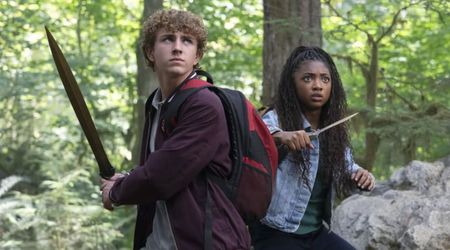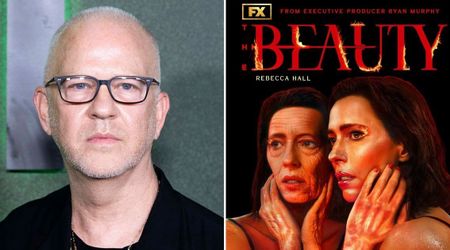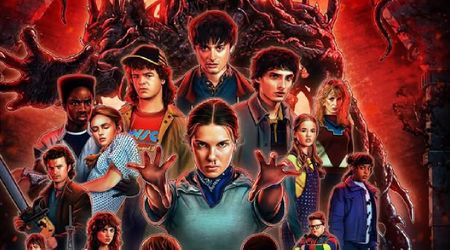'His Dark Materials' Episode 2 delves into the making of the daemons as show tries to recreate Philip Pullman's vision

The mythology of Philip Pullman's 'His Dark Materials' trilogy is deeply intertwined with daemons and what they stand for in Lyra's world. In the books, daemons are the physical manifestations of a person's inner self, the parts of the psyche -- qualities that we ascribe to a person's soul. Qualities that we sometimes also describe as our inner demons when we second-guess our actions. It is that voice within that doesn't let us rest when we are not being our best selves.
In Lyra's world, this implicit inner world is made explicit through the daemons, the talking animal companions (most often of the opposite gender) who can never stray far from their humans because it is too painful to sever the invisible tether that binds them.
In the books, the form daemons take and their actions and words tell you more about people's true selves. So it's no surprise that children, who are still unformed, have shape-shifting daemons that "settle" once they reach puberty. The daemon's final form is defined by the person's true nature.
In a BBC Radio webchat, Pullman said: "You have to remember that you [the person] and the daemon are not separate beings - you are one being in two bodies." So the noble Lord Asriel who likes the snowy North has a female snow leopard called Stelmaria. The enigmatic and beautiful Mrs Coulter has a gorgeous golden monkey, who acts as a silent thuggish bodyguard and has no name in the books.
The fact that she is reluctant to call her soul/daemon by name and its silence is telling since it shows that Mrs. Coulter has something to hide. On the BBC-HBO show, episode 2 has the added twist of Mrs Coulter slapping her daemon who flinches -- it shows her tortured relationship with her inner self and speaks to how she hates herself.

The Gyptians mostly have birds as daemons, given their lives as nomads, while the Magesterium officials seem to have reptiles or bugs, a reference to their corruption. While the concept of daemons is a wonderfully imagined and fully realized narrative device in Philip Pullman's books, visual adaptations have found this aspect of 'His Dark Materials' to be particularly troublesome to adapt.
Talking animals, for most viewers, belong to a fantastical and juvenile world thanks to our conditioning through Walt Disney's cartoons and other beloved classics like 'Winnie the Pooh' or 'Peter Rabbit'. Even Aslan, the majestic lion of CS Lewis' Narnia, the most serious talking animal depicted onscreen, is fantastical because he is a stand-in for the Divine (and depicted as such in the films, complete with a golden glow to add to his gravitas).
But daemons are a commonplace, banal fact of life in Lyra's world. They are not extraordinary. To make talking animals seem natural and ordinary in the visual medium is challenging. It is a challenge that the BBC-HBO 'His Dark Materials' show has taken up with mixed results. In a video released by BBC 1, the show's creators explain how they brought the daemons to life.
Jane Tranter, executive producer of the show, said every early on it was decided that the daemons would have to be "full-on, furry critters, CGI, photo-real." She added, "the daemon animals had to give a performance, representing something of what the character is thinking or feeling." To do this, there were on-set puppeteers with puppets with varying levels of detail, depending on the scope of individual scenes -- from complex rendering to more simple figurines -- based on the characters' daemons.

According to Russell Dodgson, the VFX supervisor on 'His Dark Materials', while they were familiar with the CGI work involved in bringing these animals to life, the problem was the volume since it is expensive to create a large number of CGI animals per episode. It was a problem that 'Game of Thrones' solved by omitting the dire wolves whenever they could. But on the show, the daemons are such an integral part of each character that each time they disappear from view, like that breakfast scene on the terrace, you wonder where they are.
Episode 2 also fumbles a little by telling the viewers explicitly some of the things that could have been shown. For example, daemons not being able to stray far from their humans. Did we need Pan to say that it "hurts him" to be away from Lyra? Isn't Lyra's shock at seeing the golden monkey in the study speak volumes to indicate how strange it is to have the monkey wander so far away from Mrs. Coulter
Viewers can also be left a bit confused about the children's shape-shifting daemons because they could think they can shift into anything. It hasn't been shown why Pan only turns into a moth, ermine or pine marten, for instance. It is never explained, through situations, that Lyra has a set number of internal responses, even with the changeable nature of a child. Her daemon shifts within this spectrum of behavior that she exhibits.
It would also have helped to not have the animals talk conventionally with moving mouths. Instead, voice artists could have spoken the dialogues as a voiceover, to create the impression that the daemons were conversing privately with their humans, mentally, and matched the dialogue with appropriate facial and physical gestures of the daemon.
But there are also moments of subtlety on the show. When Lord Boreal catches and then crushes the snooping journalist's butterfly daemon, it shows the taboo nature of handling someone else's daemon and also how killing a daemon kills their human as well. Similarly, Pan cowering when the golden monkey strokes it, is a show of Mrs. Coulter's dominance over Lyra, as much as that earlier scene where her golden monkey attacks Pan.
Overall, the life-like animals, thanks to CGI work, do make the show one of the better adaptations to date. Here's hoping they cut down on the expositionary dialogue to make the show even more compelling.
'His Dark Materials' airs weekly, every Monday, at 9 p.m. on HBO.










